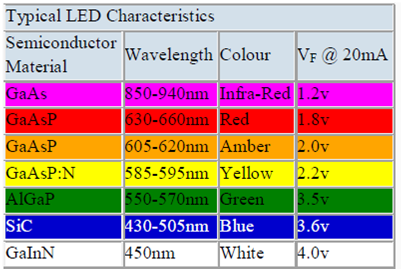Light Emitting Diode Colours
Not like normal signal diodes which are made for the detection or power rectification, and which are made from Germanium or Silicon semiconductor materials, Light Emitting Diodes are made from the exotic semiconductor compounds like Gallium Arsenide (GaAs), Gallium Arsenide Phosphide (GaAsP), Gallium Phosphide (GaP), Silicon Carbide (SiC) or Gallium Indium Nitride (GaInN) all are mixed together at different ratios to generate a distinct wavelength of color. Different LED compounds emit light in the specific regions of visible light spectrum and therefore produce different intensity levels. The exact choice of semiconductor material used will decide the overall wavelength of photon light emissions and thus the resulting color of the light emitted.

Therefore, the actual color of a light emitting diode can be determined by F wavelength of the light emitted, which in turn can be determined by the actual semiconductor compound used in forming PN junction during manufacture and NOT by coloring of the LEDs plastic body although these are slightly colored to enhance the light and indicate its color when its not be used. The Light emitting diodes are available in a wide variety of colors with the most common being AMBER, RED, YELLOW and GREEN and are hence widely used as visual indicators and as the moving light displays.
Freshly developed blue and white colored LEDs are available as well but these tend to be much more costly than normal standard colors because of the production costs of the mixing together two or more complementary colors at the exact ratio within a semiconductor compound and by injecting the3 nitrogen atoms also into the crystal structure during the process of doping.
From the table given above we can see that the main P-type dopant which is used in manufacture of the Light Emitting Diodes is Gallium (Ga, having atomic number 31) and that the main N-type dopant which is used is Arsenic (As, atomic number 31) providing the resulting compound of Gallium Arsenide (GaAs) crystal structure. The problem with using the Gallium Arsenide on its own as semiconductor compound is that it radiates large quantity of low brightness infra-red radiation (850nm-940nm approx.) from its junction when the forward current is flowing from it. This infra-red light is fine for television remote controls but not much useful if we want to use LED as an indicating light. But if we add Phosphorus (P, atomic number 15), as a third dopant then the overall wavelength of emitted radiation is reduced to under 680nm giving visible red light to human eye. Further refinements in the process of doping of the PN junction have resulted in the range of colors spanning the spectrum of visible light as we have seen above table as well as infra-red and the ultra-violet wavelengths.
By mixing together a range of semiconductor, metal and gas compounds following list of LEDs can be produced.
- Gallium Arsenide (GaAs) - infra-red
- Gallium Arsenide Phosphide (GaAsP) - red to infra-red, orange
- Aluminium Gallium Arsenide Phosphide (AlGaAsP) - high-brightness red, orange-red, orange, and yellow
- Aluminium Gallium Phosphide (AlGaP) - green Zinc Selenide (ZnSe) - blue
- Gallium Nitride (GaN) - green, emerald green
- Gallium Indium Nitride (GaInN) - near ultraviolet, bluish-green and blue
- Silicon Carbide (SiC) - blue as a substrate
- Gallium Phosphide (GaP) - red, yellow and green
- Aluminium Gallium Nitride (AlGaN) - ultraviolet
Similar to conventional PN junction diodes, LEDs are the current-dependent devices with its forward voltage drop VF, depending on semiconductor compound (its light color) and on forward biased LED current. The point where conduction starts and light is produced is about 1.2V for a standard red LED to around 3.6V for the blue LED. The exact voltage drop will certainly depend on manufacturer due to the different dopant materials and wavelengths used. The voltage drop across LED at the particular current value, for instance 20mA, will also depend on initial conduction VF point. As a LED is effectively a diode, its forward current to voltage characteristics curves can be plotted for each diode color
Email based Electronics Devices and circuits assignment help - homework help at Expertsmind
Are you searching Electronics Engineering assignment help expert for help with Light Emitting Diode Colours questions? Light Emitting Diode Colours topic is not easier to learn without any external help? We at www.expertsmind.com offers free lecture notes for Electronics Devices and circuits assignment help and Electronics Devices and circuits homework help. Live tutors are available 24x7 hours for helping students in their Light Emitting Diode Colours related problems. We provide step by step Light Emitting Diode Colours question's answers with 100% plagiarism free content. We prepare quality content and notes for Light Emitting Diode Colours topic under Electronics Devices and circuits theory and study material. These are avail for subscribed users and they can get advantages anytime.
Why Expertsmind for assignment help
- Higher degree holder and experienced experts network
- Punctuality and responsibility of work
- Quality solution with 100% plagiarism free answers
- Time on Delivery
- Privacy of information and details
- Excellence in solving electronics engineering questions in excels and word format.
- Best tutoring assistance 24x7 hours